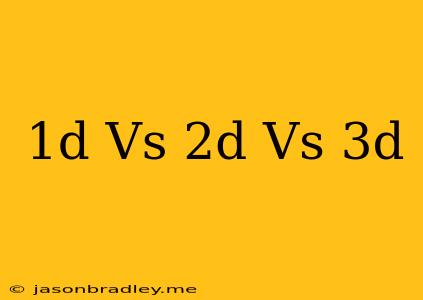Oke, berikut artikelnya:
1D, 2D, and 3D: Understanding the Dimensions
In the world of computer graphics, geometry, and even our everyday experience, we often encounter the terms 1D, 2D, and 3D. These terms refer to dimensions, which define the number of independent directions or axes needed to specify a point in space.
1D: The Line
Imagine a straight line extending infinitely in both directions. This is a one-dimensional space, where a single number (the coordinate) is sufficient to define any point on the line. Think of a number line where each point has a unique numerical value. Examples of 1D objects include:
- A line segment: A portion of a line with a defined starting and ending point.
- A number line: Used in mathematics to represent real numbers.
- A straight path: Imagine a car driving along a perfectly straight road.
2D: The Plane
When we move to two dimensions, we introduce a second axis perpendicular to the first. Now, a point can be defined by two coordinates, commonly denoted as (x, y). This creates a plane, which can be visualized as a flat surface extending infinitely in all directions within its two dimensions. Examples of 2D objects include:
- A square: A four-sided shape with all sides equal and all angles right angles.
- A circle: A closed curve consisting of points equidistant from a center.
- A map: A representation of a geographic area on a flat surface.
3D: The Real World
The world we live in is three-dimensional. We need three axes (x, y, and z) to define a point in space. This gives us the ability to represent objects with volume and depth. Examples of 3D objects include:
- A cube: A three-dimensional shape with six square faces.
- A sphere: A three-dimensional object where all points on the surface are equidistant from the center.
- A human being: We exist in three dimensions and can move freely in all directions.
Beyond 3D
While our physical world is 3D, mathematical concepts and theoretical physics explore higher dimensions. These are difficult to visualize, but they are used in advanced theories and models.
Applications of 1D, 2D, and 3D
- Computer Graphics: 2D and 3D are essential for creating images, animations, and video games.
- Engineering: 3D models are used in designing structures, vehicles, and other complex objects.
- Physics: 1D, 2D, and 3D models are used to simulate physical phenomena.
Understanding dimensions is fundamental to various fields, and it plays a crucial role in how we perceive and interact with the world around us.
